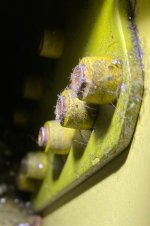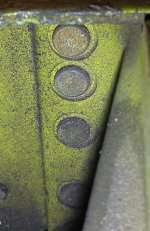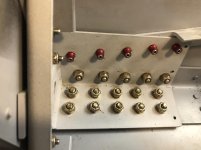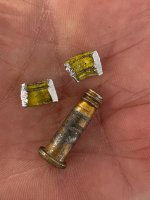Van's Air Force
You are using an out of date browser. It may not display this or other websites correctly.
You should upgrade or use an alternative browser.
You should upgrade or use an alternative browser.
Removing bolts
- Thread starter Tomas J
- Start date
planenutz
Well Known Member
It looks like these might be Huck Bolts, or a version of them. As CATpart said, these are permanent.
On this kind of fastener the collar is either squeezed or driven onto the shank in a similar manner to riveting and its a one way action. They're very good in structural applications but they're a bear to remove. You can use a cold chisel to try and split the collar however in doing so you need a dolly on the underside, otherwise you transfer the load of the hammer impact into the structure and it will stretch the parent material, elongating your hole. If you have sufficient access you can drill them out in stages (small drill size first, increasing in size as you go) but as the core is steel and your surrounding structure is likely to be aluminium you have to be careful not to drill off centre. You could also try a dremel tool to cut the collar off. Regardless of teh method you choose, put aside some time because it will not be a five minute job.

On this kind of fastener the collar is either squeezed or driven onto the shank in a similar manner to riveting and its a one way action. They're very good in structural applications but they're a bear to remove. You can use a cold chisel to try and split the collar however in doing so you need a dolly on the underside, otherwise you transfer the load of the hammer impact into the structure and it will stretch the parent material, elongating your hole. If you have sufficient access you can drill them out in stages (small drill size first, increasing in size as you go) but as the core is steel and your surrounding structure is likely to be aluminium you have to be careful not to drill off centre. You could also try a dremel tool to cut the collar off. Regardless of teh method you choose, put aside some time because it will not be a five minute job.
Looking at the dirty collar, I think you guys might be right. I don’t think I’ve ever seen a huck in a non-production aircraft. This one would be puzzling as don’t you loose a major advantage (over other high strength fasteners) when not getting the speed associated with production/installation equipment?
OP might want to invest in one of the dedicated cutters/removers. As the smart guys have stated, it’s very easy to screw up the structure. Access might be an issue. Best of luck.
OP might want to invest in one of the dedicated cutters/removers. As the smart guys have stated, it’s very easy to screw up the structure. Access might be an issue. Best of luck.
BillL
Well Known Member
This is not an RV fastener.
I just worked with these - - Walt hit the mark, several tools are available and while the removal is not hard, getting to them is a puzzle.
Recommend you do some research on the replacement alternative as the options are limited and not as compact as the originals.
I just worked with these - - Walt hit the mark, several tools are available and while the removal is not hard, getting to them is a puzzle.
Recommend you do some research on the replacement alternative as the options are limited and not as compact as the originals.
Last edited:
……Recommend you do some research on the replacement alternative as the options are limited and not as compact as the originals.
Hi-Loks. I’m an admitted FanBoy. One sided installation. Wide variety of materials/strengths/applications. No special tools to install. Lock nuts (check thread type) can be used instead of the collars. Remove with Allen wrench (or regular wrench if locknuts used) and small vice grips. I would definitely not reinstall hucks.
Just an option. The OP will hear plenty
Edit = changed female fastener comments.
Attachments
Last edited:
BillL
Well Known Member
Tight is relative.
Are Hucks even still available? I was told they aren't. My recent experience is helping on a 172 main gear forging replacement. Originally Huck style, and the hi-loks blocked some rivets for reinstallation and interfered with the U-bolt nuts.
They were easy to install if there is room and not crazy expensive.
These had to be spherical washers due to the contact on the forge draft angle and were taller than the swaged collar style. Apparently +.150" was too much for the downstream assembly. Really not more tricky or required assembly order critical than some RV stuff, just different processes and tools.
I would definitely not reinstall hucks.
Are Hucks even still available? I was told they aren't. My recent experience is helping on a 172 main gear forging replacement. Originally Huck style, and the hi-loks blocked some rivets for reinstallation and interfered with the U-bolt nuts.
They were easy to install if there is room and not crazy expensive.
These had to be spherical washers due to the contact on the forge draft angle and were taller than the swaged collar style. Apparently +.150" was too much for the downstream assembly. Really not more tricky or required assembly order critical than some RV stuff, just different processes and tools.
Hi-Loks. ... Can use AN nuts instead of the collars.
You cannot use AN nuts on Hi-Loks.
Hi-Loks use UNJ threads and AN uses UNF threads.
A UNJ nut can be used on a UNF bolt of the same pitch, but a UNF nut cannot be used on a UNJ bolt.
UNJ threads, on the bolt, have a larger radius at the root of the thread, providing enhanced fatigue life. UNJ nuts therefore have a slightly larger ID so not to interfere with that radius. Using UNF nuts you may interfere with the root radius of the UNJ bolt. They are not compatible.
You cannot use AN nuts on Hi-Loks.
Hi-Loks use UNJ threads and AN uses UNF threads.
A UNJ nut can be used on a UNF bolt of the same pitch, but a UNF nut cannot be used on a UNJ bolt.
UNJ threads, on the bolt, have a larger radius at the root of the thread, providing enhanced fatigue life. UNJ nuts therefore have a slightly larger ID so not to interfere with that radius. Using UNF nuts you may interfere with the root radius of the UNJ bolt. They are not compatible.
If correct then my apologies. We utilized them quite a lot on the space shuttle way back. Quite a decent percentage used non-Hi-Lok female fasteners in structure that would require service. The call-outs were MS or NAS, IIRC. I assumed there was an AN equivalent. I changed the aforementioned verbiage.
Don’t let my mis-ramblings negatively influence you. They’re a great (underutilized IMO) product.
Last edited:
Marc Bourget
Well Known Member
I understand Hucks and Hi-Shears are precision installation. AN Bolts have a both larger and incompatible diameter specs.
While an AN Bolt may meet the Fs specs, strength and service life would be compromised.
While an AN Bolt may meet the Fs specs, strength and service life would be compromised.
fixnflyguy
Well Known Member
Very common in production aircraft
What you have their is a typical pulled pin and swedge collar bolt. There are several names depending on vendor. I have dealt with them for years in heavy jet structure and some GA aircraft. They are similar to Hiloks, and when we do repairs, Hiloks are the replacement. I have installed them, and it requires specialized tooling. Removal is typically by drilling the head off and driving the shank/collar out. Most are installed transition fit which is slight interference. I built my RV-4 with extensive titanium Hilok use which is a similar fastener using a thread on collar that shears off the driving device at torque spec. An AN bolt or NAS bolt would be a viable replacement, but would not be in transition fit. I'm not understanding if your picture is from an RV or a production aircraft. It appears the head side is also counter-bored slightly for flat head contact critical to this type fastener.
What you have their is a typical pulled pin and swedge collar bolt. There are several names depending on vendor. I have dealt with them for years in heavy jet structure and some GA aircraft. They are similar to Hiloks, and when we do repairs, Hiloks are the replacement. I have installed them, and it requires specialized tooling. Removal is typically by drilling the head off and driving the shank/collar out. Most are installed transition fit which is slight interference. I built my RV-4 with extensive titanium Hilok use which is a similar fastener using a thread on collar that shears off the driving device at torque spec. An AN bolt or NAS bolt would be a viable replacement, but would not be in transition fit. I'm not understanding if your picture is from an RV or a production aircraft. It appears the head side is also counter-bored slightly for flat head contact critical to this type fastener.
.....An AN bolt or NAS bolt would be a viable replacement, but would not be in transition fit......
Was hoping you'd reply. Can you get me smarter on the above comment?
If the non-collar female fastener utilizes a properly sized washer(s) (full shank engagement, thread transition in the washer space), then what is the difference?
Always got a kick out of the manufacturer's instructions. A slight interference fit but were called out to be installed wet (koropon primer way back?) I did it anyway but always wondered why/if any real benefit was gained. Maybe a little protection between the head and stack but that's not the critical interface.
Looking forward to your reply.
fixnflyguy
Well Known Member
Transition fit
Transition fit ensures best full surface contact of the fastener and materials being joined. Joint failure typically occurs when movement starts and surface contact isn't optimal. Fasteners installed "wet" with primer helps mitigate dissimilar metal corrosion issues. Hilocks are driven in place before the collar is seated, whereas the questioned fastener is pulled via breakaway stem from the collar side and then the collar is swedged on what looks like threads, but is usually just ringed. The collar is most often aluminum and can be mechanically removed with a forked collar buster, but mismanaged will cause damage to the hole and or surrounding structure. Installation requires the hole size be slightly smaller than the fastener diameter. For a 3/16 Hilok in standard size, the hole is basically a #13 instead of a #10 like an AN bolt would go in.
Transition fit ensures best full surface contact of the fastener and materials being joined. Joint failure typically occurs when movement starts and surface contact isn't optimal. Fasteners installed "wet" with primer helps mitigate dissimilar metal corrosion issues. Hilocks are driven in place before the collar is seated, whereas the questioned fastener is pulled via breakaway stem from the collar side and then the collar is swedged on what looks like threads, but is usually just ringed. The collar is most often aluminum and can be mechanically removed with a forked collar buster, but mismanaged will cause damage to the hole and or surrounding structure. Installation requires the hole size be slightly smaller than the fastener diameter. For a 3/16 Hilok in standard size, the hole is basically a #13 instead of a #10 like an AN bolt would go in.
Was hoping you'd reply. Can you get me smarter on the above comment?
The shank diameter on the Hi-Loks and these Hucks are slightly larger than the major diameter of the threads (hucks are not really threaded). This way when you insert them into a precision hole the threads will freely pass through the hole, but then the shank will not. This allows only the shank to experience the desired interference fit. There are NAS or MS bolts out there that are of similar geometry and used for the same purpose. Your more typical hardware is not made to these specifications.
cvairwerks
Well Known Member
Looks like NAS1446 lock pins. To remove, all you need to do is split the collars and tap the pin out. Takes specialized hydraulic tooling for installation. Hilock or Eddie Bolts should be the standard replacement when you don't have the tooling or the space for shooting in new 1446's
BillL
Well Known Member
Looks like NAS1446 lock pins. To remove, all you need to do is split the collars and tap the pin out. Takes specialized hydraulic tooling for installation. Hilock or Eddie Bolts should be the standard replacement when you don't have the tooling or the space for shooting in new 1446's
Eureka! - - So not Huck brand, it is a Mil STD 1759 product on page 145, called lock bolts. That page from every spec has the dimensions and all variants to select the correct NAS numbers including the various collars. From that document one can find the precise part numbers and have a change of locating some surplus stock. Tool - another matter.
Thanks for the tip.
Last edited:
cvairwerks
Well Known Member
Bill: Huck makes them as well as other companies. In the plant, all our tools for them were Huck. To us, the were know in general as "purple collars" whether they were countersunk or protruding head. Tools are out there, but if you are looking at pulling them in a confined area, you would probably need a offest type head and intensifier for it. Probably about 4-6 grand on the used market these days.
Last edited:
fixnflyguy
Well Known Member
Replace with a Hilok
Just replace with a Hilok and be done with it..no super special tools needed. Most all the Aircraft SRMs will specify use of Hiloks when replacing a lockbolt for repair or replacement. Forget trying to pull a lock bolt and swedge collar. Surely there is a heavy jet mechanic in your circle somewhere with access to some Hiloks and correct reamers to give you a hand.
Just replace with a Hilok and be done with it..no super special tools needed. Most all the Aircraft SRMs will specify use of Hiloks when replacing a lockbolt for repair or replacement. Forget trying to pull a lock bolt and swedge collar. Surely there is a heavy jet mechanic in your circle somewhere with access to some Hiloks and correct reamers to give you a hand.








